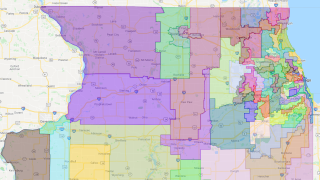
Illinois lawmakers held a hearing Tuesday afternoon on the new proposed legislative maps that Democrats, who hold a majority of seats in both chambers, released last week as part of the redistricting process.
The hearing was a joint House and Senate meeting at 4 p.m. at the Capitol in Springfield, with options for both virtual and in-person testimony.
The hearing was the first of four scheduled this week to gather feedback from members of the public before the legislature votes on the maps:
- May 25 at 4 p.m. – Joint House and Senate Hearing
- May 25 at 6 p.m. – House Hearing
- May 26 at 4 p.m. – Joint House and Senate Hearing
- May 26 at 6 p.m. – Senate Hearing
Feeling out of the loop? We'll catch you up on the Chicago news you need to know. Sign up for the weekly Chicago Catch-Up newsletter here.
Representatives notes that previously recorded census data was unable to accurately document all communities impacted by the newly released maps, raising concerns with the process.
Grace Chan McKibben, representative from Coalition for a Better Chinese American Community, noted that particular demographic data was not released with the maps, as well.
"The legislative map that was released by the Senate and House Redistricting Committee on May 21 leaves many questions unanswered of most concern is that the underlying demographic data were not released with the map," McKibben said. "As others have mentioned, this leaves community based organizations struggling right now to match published census tract data with the proposed districts."
Chicago Politics
Democrats in the Illinois General Assembly released the draft versions of the proposed legislative maps on Friday evening.
Redistricting is the process of redrawing the boundaries of district maps for both chambers of the state legislature and the U.S. House districts, as well as other units of state and local government. The process is completed every 10 years in each state across the country following the U.S. Census and has the power to shape a state's politics for the next decade and beyond.
The redistricting process in every state is governed by the individual laws of that state. In Illinois, the state Constitution gives the General Assembly the power to redraw the maps. Per the Illinois Constitution, the legislature is required to create and approve of the new maps by June 30.
Democrats control both the Illinois House and Senate, by and large giving them the power to control the redistricting process and draw each district's boundaries that will remain in place for the next 10 years.
There are 118 districts in the Illinois House, 59 in the state Senate and soon to be 17 U.S. House districts. The boundaries of all districts are required by the Constitution to be "compact, contiguous and substantially equal in population" though that mandate leaves plenty of room for interpretation.
The Senate and House Redistricting Committees, both chaired by Democrats, said Friday that the map "incorporates suggestions gathered during more than 45 public hearings held across the state as legislators sought input on how to best ensure communities across Illinois receive fair and equal representation."
The proposed House districts are below:
The proposed Senate districts, each containing two House districts, are below:
If no redistricting plan is approved by June 30, a Legislative Redistricting Commission must be created by July 10. That commission will consist of eight members, four from each political party. The speaker of the House, the House minority leader, the Senate president and the Senate minority leader can each appoint one lawmaker and one other person who is not a member of the General Assembly.
By August 10, that commission would be required to file a redistricting plan with the Illinois Secretary of State that is approved by at least five members. If the commission can't come to an agreement or fails to file new maps by that deadline, the Illinois Supreme Court then submits two people of different political parties to the Secretary of State by September 1.
By September 5, the Secretary of State is then required to publicly draw the name of one of those two people at random to serve as the ninth tie-breaking member of the commission. The commission would then be required to submit a redistricting plan with approval of five of the now-nine members by October 5.
This year, the release of U.S. Census data was delayed by the coronavirus pandemic, with what's known as "block-level" population and demographic data from the 2020 Census not scheduled to be released until mid-August at the earliest, then in the properly-formatted file for states' redistricting process by Sept. 30 at the latest.
That data is usually given to states in March each year following the Census, in time for states to use it in the redistricting process. But this cycle's delay puts the data release well after the June 30 deadline for new maps that's mandated in the Illinois Constitution - so lawmakers said they turned to other sources in creating the draft maps.
Democrats said in releasing the proposed maps on Friday that the redistricting committees created the maps using information from the American Community Survey’s five-year estimate for 2019, which they said varies by 0.3% from Illinois' official population count released by the Census Bureau in April.
Republican members of the committees denounced the draft maps on Friday, calling it "an effort to block fair elections" as they continued their criticism of a political process that has long been shrouded in secrecy.
Redistricting gives enormous power to those responsible for drawing the maps, with some saying that it enables politicians to choose their voters, rather than the other way around.
The political party in power during a partisan redistricting process oftentimes may seek to draw maps that are more advantageous to their incumbent members, like cutting out an area of a district that is the other party's stronghold, or dividing up a community into multiple districts to distill its political power, or redrawing an opponent's district to make it more difficult for them to hold their seat.
Those efforts can have the effect of stacking the deck in the party's favor in upcoming elections, in order to keep control of the legislature.
Because the maps are drawn every 10 years, they remain in place for the next five election cycles - with the potential to give the party that drew the map an advantage for a full decade and possibly even longer, should they retain control.
The new maps take effect in the upcoming 2022 election cycle, when every candidate in the statehouse and U.S. House is on the ballot. Members of both the Illinois House and the U.S. House run every two years, while Illinois Senate seats operate on a staggered, alternating schedule of two four-year terms and one two-year term.
Candidates can begin circulating petitions to get on the ballot in the March 2022 primary elections as early as Aug. 31, according to the Illinois State Board of Elections. If the legislature doesn't have the new maps ironed out by then (or if lawmakers don't move that date back), it's possible some candidates could begin circulating petitions for districts that haven't even been officially drawn yet.



